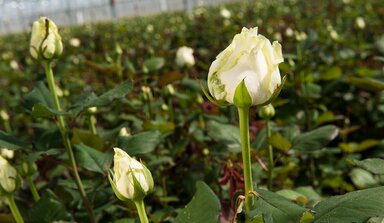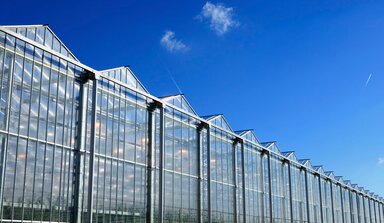Perfect roses without blackening under ReduFlex Blue
The Cananvalle rose farm in Ecuador uses ReduFlex Blue against blackening of the petals. This saves a lot of labour. Furthermore, they harvest longer stems and the greenhouse climate is more pleasant to work in.
In many countries, red roses have a deeply symbolic value. For this reason, perfect looks are more important for them than for other species of flowers. After all, you wouldn’t give someone a present that was less than perfect. This is why blackening of the petals on red cultivars form a major obstacle to sales, even if the flower is otherwise unblemished.
In the 1980s Israeli researchers delved into this issue. Their studies revealed that UV radiation was behind it and that low temperatures made the problem worse. However, if you manage to block out the UV radiation effectively, any temporary cold temperatures no longer affect the flowers.

Arturo Salazar - The Cananvalle Rose Farm
UV in plastic greenhouses
It is therefore unsurprising that the problem occurs especially in plastic greenhouses. This is because, unlike glass, plastic allows UV to pass through it. For this reason, new films that feature a UV blocker are now available, although they tend to degrade over time. This means the greenhouse cover lets more and more UV light in and the blackening issue worsens.
The Cananvalle rose farm in Ecuador was suffering this problem with the Freedom variety. ‘Although we usually only saw blackening to the edges of the petals, it occasionally affected the whole flower. In order to prevent this happening, we enveloped each rosebud with a small plastic net to protect it from UV radiation. This meant a lot of extra work,’ explains Arturo Salazar.
Blocking UV effectively
Mardenkro recommended trying out ReduFlex Blue to tackle the issue. The coating was originally developed for the purpose of reducing the portion of blue in the PAR light. However, readings in Mardenkro’s own laboratories showed that ReduFlex Blue also blocks out virtually the whole UV spectrum (250-400 nm).
‘From July 2017 onwards we tested ReduFlex Blue on 2500 m2. Since we have the same climate all year round, the coating stayed intact. We took care to ensure the layer was applied very uniformly,’ says Salazar.
‘We are really enthusiastic about the results. Not only has the issue of blackening been strongly reduced, but we are also seeing longer stems. Together these effects are improving production. The colour of the flower is also better,’ he concludes.
Better working conditions
An additional benefit is that the staff find working in the coated greenhouse more pleasant. It is a little cooler in there than it used to be. The reason for this is that ReduFlex Blue also blocks heat (near-infrared) radiation. ‘We are very happy with the results and so far we haven’t seen any drawbacks. For this reason we are going to apply ReduFlex Blue to a larger area and with other varieties,’ says the manager of the enterprise.
Another rose farm in Ecuador has since been enjoying similar experiences with ReduFlex Blue as well.


